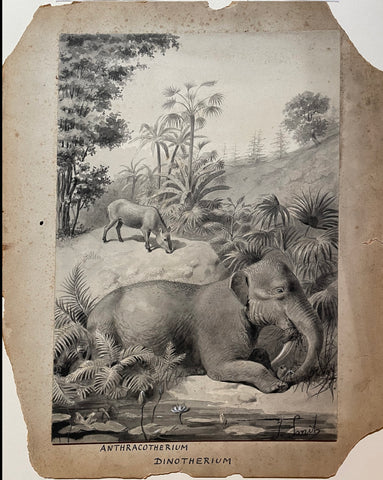
Joseph Smit (1836-1929), 1. Anthracotherium (Background) and 2. Deinotherium (Foreground)
Joseph Smit (1836-1929)
1. Anthracotherium (Background) and 2. Deinotherium (Foreground)
Original Illustration in pen, ink and grey wash, heightened in white.
c. 1905-1912.
10 5/8 x 7 1/4 in. sheet
Original artwork for Henry R. Knipe’s Nebula to Man. Illustrated on page 160: “Anthracotherium / (The remains are found in Europe, India and North America”. “Dinotherium / (The remains are widely distributed in Miocene deposits of Central Europe, but have not been found in America).”
1. Anthracotherium (“Coal Beast”) was a genus of extinct artiodactyl ungulate mammals, characterized by having 44 teeth, with five semi-crescentic cusps on the crowns of the upper molars. The genus ranged from the middle Eocene period until the early Miocene, having a distribution throughout Eurasia. Material subjectively assigned to Anthracotherium from Pakistan suggests the last species died out soon after the start of the Miocene. In many respects, especially the anatomy of the lower jaw, Anthracotherium, as with the other members of the family, is allied to the hippopotamus, of which it is probably an ancestral form. Anthracotheres, together with hippos, are grouped with cetaceans in the clade Whippomorpha.
The European Anthracotherium magnum was approximately as large as a pygmy hippo (about 2 m long and weighing up to 250 kg), but there were several smaller species and the genus also occurs in Egypt, India and North America. Members of the genus Anthracotherium, as well as other members of the family Anthracotheriidae, are known colloquially as anthracotheres.
2. Deinotherium (“terrible beast” derived from the Ancient Greek, deinos meaning “terrible” and, therion meaning “beast”) was a large prehistoric relative of modern-day elephants that appeared in the Middle Miocene and survived until the Early Pleistocene. During that time, it changed very little. In life, it probably resembled modern elephants, except it had downward-curving tusks attached to the lower jaw.
Deinotherium was a large proboscidean, measuring between 3.6–4.0 m (11.8–13.1 ft) tall and weighed 8.8–12 tonnes.Deinotherium is distinguished from its predecessor Prodeinotherium by its much greater size, greater crown dimensions, and reduced development of posterior cingula ornamentation in the second and third molars. Deinotherium’s range covered parts of Asia, Africa, and Europe.
JOSEPH SMIT (1836-1929)
Josef Smit’s dinosaur drawings are a high point in his fine draughtsmanship and unique in his vision to construct an image based on a written description rather than a physical specimen. Knipe’s preface indicates that Smit also learned much from Charles Knight’s drawings at the Museum of Natural History, New York.
Josef Smit was born and raised in Lisse, in southern Holland. Later, in Leiden, his scientific fidelity came to the Natural History Museum of Leiden director Hermann Schlegel’s attention. He presented the artist with his first commission to paint a series of birds from the Dutch East Indies. Smit’s work for Schlegel earned him a significant commission to prepare hundreds of plates for Philip Sclater’s Exotic Ornithology. Once in London, the artist met other like-minded artist-naturalists and developed a reputation for preparing very realistic drawings. Because of his ability to delineate every detail of a specific bird, he was employed by several scientists to illustrate their reports and publications. His work stood apart from his contemporaries in his addition of thorough backgrounds of leaves, vines, and tree branches. Smit eventually became a key contributor to some of the most important natural history publications of the 19th and early-20th centuries. His work graced the tomes by John Gould, Edward Lear, Archibald Thorburn, Henry Constantine Richter, and J.G. Keulemans. His son, Pierre-Jacques Smit was also a skilled watercolorist.
ORIGINAL WATERCOLORS PREPARED FOR HENRY KNIPE’S
NEBULA TO MAN (1905) & EVOLUTION IN THE PAST (1911-1912)
An exceedingly rare collection of original watercolors prepared for Henry Knipe’s Nebula to Man (1905) and Evolution in the Past (1911-1912) by naturalist-artists Alice Woodward, Josef Smit, and Charles Whymper.
Drawings prepared for Knipe’s Nebula to Man (1905) contributed to one of the most important publications on dinosaurs on the heels of the Great Dinosaur Rush or Bone Wars. The Bone Wars occurred between 1877 and 1892 between Edward Drinker Cope, the Academy of Natural Sciences Philadelphia, and Othniel Charles Marsh, the Peabody Museum of Natural History at Yale. These early paleontologists fought ruthlessly to pursue dinosaur fossils, a quest that resulted in an extraordinary period of discovery and the eventual financial ruin of both scientists. Their findings resulted in unearthing 136 new dinosaur species, ushering in a new paleontological research era.
According to Henry Knipe’s obituary, he worked for the British Museum. It was there that he likely met the artists tapped for this project. Knipe chose each illustrator for their reputation for scientific authenticity—namely, those skilled as bird artists, given the many similarities between bird species and dinosaurs.
We Also Recommend

![Albertus Seba (1665-1736) Tab I [Insects]](http://aradergalleries.com/cdn/shop/products/I_large.jpg?v=1635434052)
![Albertus Seba (1665-1736) Tab II [Insects]](http://aradergalleries.com/cdn/shop/products/II_large.jpg?v=1635434726)
![Albertus Seba (1665-1736) Tab III [Insects]](http://aradergalleries.com/cdn/shop/products/III_large.jpg?v=1635434877)
![Albertus Seba (1665-1736) Tab L [Insects]](http://aradergalleries.com/cdn/shop/products/L_b_large.jpg?v=1635435506)
![Albertus Seba (1665-1736) Tab L [Insects]](http://aradergalleries.com/cdn/shop/products/L_large.jpg?v=1635437893)